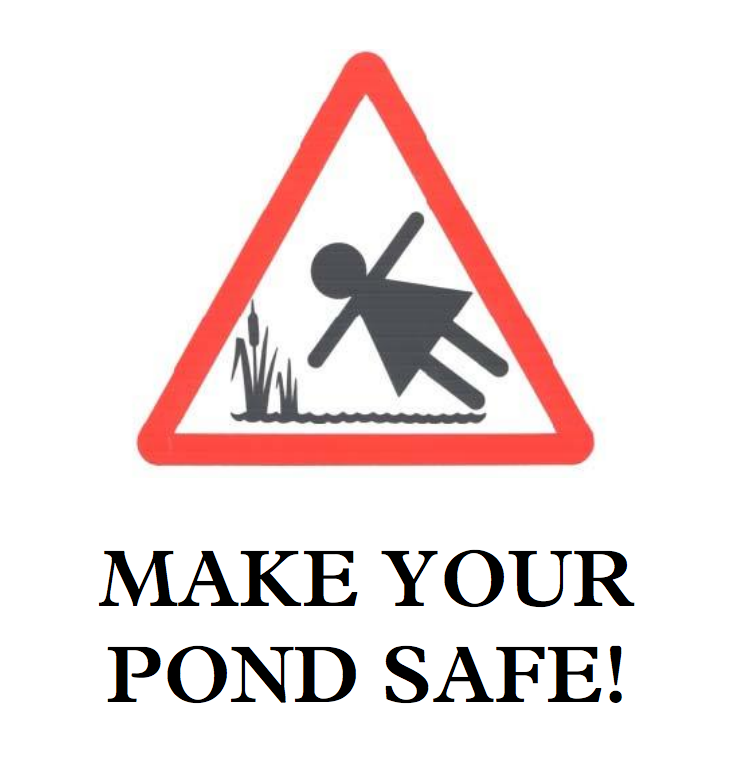How To Make Your Pond or Water Feature Safe

Water holds an irresistible attraction to people of all ages, but as we unfortunately discover each year, this can be overshadowed by tragic consequences.
As pond keepers, we need to be aware that our garden ponds & water features can be a source of danger and we need to ensure that we take all reasonable measures to minimise the risks. Figures published by The Royal Society for the Prevention of Accidents (RoSPA) indicate that ponds are just ahead of baths in terms of accidental drowning incidents involving children below the age of five. Children aged between one and two are particularly at risk, and as the child increases in age, the risk decreases. There are three main reasons for this:
- Between the ages of one and two, infant's mobility increases at a terrific, but irregular rate, such that they can escape parents' supervision and get into difficulties unexpectedly quickly.
- Whilst mobility may increase, stability and co-ordination remain poor.
- It is not until the age of four or five that children begin to understand the concept of danger, and begin to heed warnings given to them (e.g even the shallowest of ponds can be lethal- from a child's perspective a 500mm deep pond is equivalent to an adult falling into 1800mm of water, where the child is unable to climb out of the water).
It's clear that any such a tragedy is one too many, so what measures can be taken to keep loved ones safe around water in the garden?
Obviously children should be closely supervised around water at all times but rather than filling-in your pond, there's plenty of options that provide safe barriers. Fencing hazardous areas can help, making sure that any gates are designed with childproof fixings and the design is tricky to climb (such as picket fencing with vertical boards). Take care that the pond is clearly visible. Installation of pond & garden lighting will help in this respect during the darker months of the year.
Planting can also be used to form a barrier, as well as garden plants, marginal and aquatic plants can limit access to open water. However, it should be borne in mind that excessive plant growth and pests such as duckweed can give a visual impression of being ‘dry land’ and this can lead to problems in its own right.
Where this approach isn't practical, horizontal barriers above or below the water's surface are an option. Rigid mesh capable of bearing the weight of a child (and even a grown adult!) can be readily sourced, and if required, installed by some companies.
In cases where an existing pond isn't an issue, a raised feature can bring the water level up and out of harms way, as well as saving a lot of digging. Tempting though it may be, allowing children to feed the fish unsupervised can encourage associations that could be problematic. Therefore always hide any pond food so that this potential problem is removed.
Whatever option you choose to take, filling in your pond needn't be the only answer and a reversible conversion to a pebble water feature can be an elegant solution while the children are too young to know the danger.
General Pond Safety Advise:
- Young Children must ALWAYS be supervised when they are close to any open water - be it garden pond, swimming pool, river, stream or lake.
- Children under two are at particular risk because they are still unsteady on their feet.
- Grills/covers can be bought to provide either temporary or permanent cover.
- Hands should be washed after putting them in ponds, and before eating and drinking
- Shallow shelving or marshy edges can be incorporated into the design so that there is no easy access to deep water.
- Shrubs and plants can be used to make access to the pond difficult for youngsters.
Pond Electrical safety:
- Equipment should be installed by a competent electrician. The more complex the installation, the greater competence required.
- Where necessary waterproof unions, of the appropriate type should be used.
- Cables and equipment should be checked regularly. Repairs or replacements should be carried out as soon as a fault is detected.
- Circuit breakers can provide life-saving protection.
- All electrical items should be switched off if any maintenance or repair is undertaken.
Pond Chemical safety:
- Pond treatments all carry labels giving detailed instruction on its safe use and handling. When using pond treatments, the label should be carefully read and understood before proceeding. This will ensure that both you and your fish are safe.
- All chemicals should be kept out of the reach of young children at all times.



